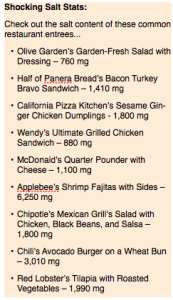Waiter, There's Salt in My Food!
 When people say that you just can’t watch your weight if you dine out regularly, I strongly disagree. There are just so many lower calorie options out there now. However, when those same people say that restaurant foods have too much sodium, I have to agree.The Dietary Guidelines for Americans recommend that adults in should consume no more than 2,300 mg of sodium per day. That recommendation drops to 1,500 mg per day if you’re 51 years of age or older, an African American, or if you have high blood pressure, diabetes, or chronic kidney disease.While there are 2,400 mg of sodium in a teaspoon of salt, you can easily reach your daily max without ever touching the salt shaker. That’s largely because some foods naturally contain sodium, much of the food in a restaurant kitchen is canned or processed, and restaurant chefs can have a heavy hand with the salt.Tips for Reducing Salt Intake:Don’t rely on your taste buds to distinguish the sodium content of a food. Did you know that a slice of bread has as much sodium as an ounce of chips? Our taste buds trick us all the time. Refer to the restaurant’s nutrition information, if it’s available.Learn to eat foods plain. Yes, many meals are loaded in sodium, but the extras -- ketchup, mayo, soy sauce, salad dressing, etc -- add even more!.Soups will always be high in sodium and so will salad dressings. Learn to enjoy salads dressed with just oil and vinegar. It’s also wise to restrict high-sodium ingredients like cheese, croutons, and olives.Avoid processed meats such as salami, ham, sausage, lunch meats etc. Consider cheese as a condiment, rather than the center of a meal. Cheese is not only high in sodium, but it is also high in unhealthful fats.By Dr. Jo® Lichten Find out more about Dr. Jo’s speaking schedule and Reboot, her upcoming book, at http://www.DrJo.com/.
When people say that you just can’t watch your weight if you dine out regularly, I strongly disagree. There are just so many lower calorie options out there now. However, when those same people say that restaurant foods have too much sodium, I have to agree.The Dietary Guidelines for Americans recommend that adults in should consume no more than 2,300 mg of sodium per day. That recommendation drops to 1,500 mg per day if you’re 51 years of age or older, an African American, or if you have high blood pressure, diabetes, or chronic kidney disease.While there are 2,400 mg of sodium in a teaspoon of salt, you can easily reach your daily max without ever touching the salt shaker. That’s largely because some foods naturally contain sodium, much of the food in a restaurant kitchen is canned or processed, and restaurant chefs can have a heavy hand with the salt.Tips for Reducing Salt Intake:Don’t rely on your taste buds to distinguish the sodium content of a food. Did you know that a slice of bread has as much sodium as an ounce of chips? Our taste buds trick us all the time. Refer to the restaurant’s nutrition information, if it’s available.Learn to eat foods plain. Yes, many meals are loaded in sodium, but the extras -- ketchup, mayo, soy sauce, salad dressing, etc -- add even more!.Soups will always be high in sodium and so will salad dressings. Learn to enjoy salads dressed with just oil and vinegar. It’s also wise to restrict high-sodium ingredients like cheese, croutons, and olives.Avoid processed meats such as salami, ham, sausage, lunch meats etc. Consider cheese as a condiment, rather than the center of a meal. Cheese is not only high in sodium, but it is also high in unhealthful fats.By Dr. Jo® Lichten Find out more about Dr. Jo’s speaking schedule and Reboot, her upcoming book, at http://www.DrJo.com/.